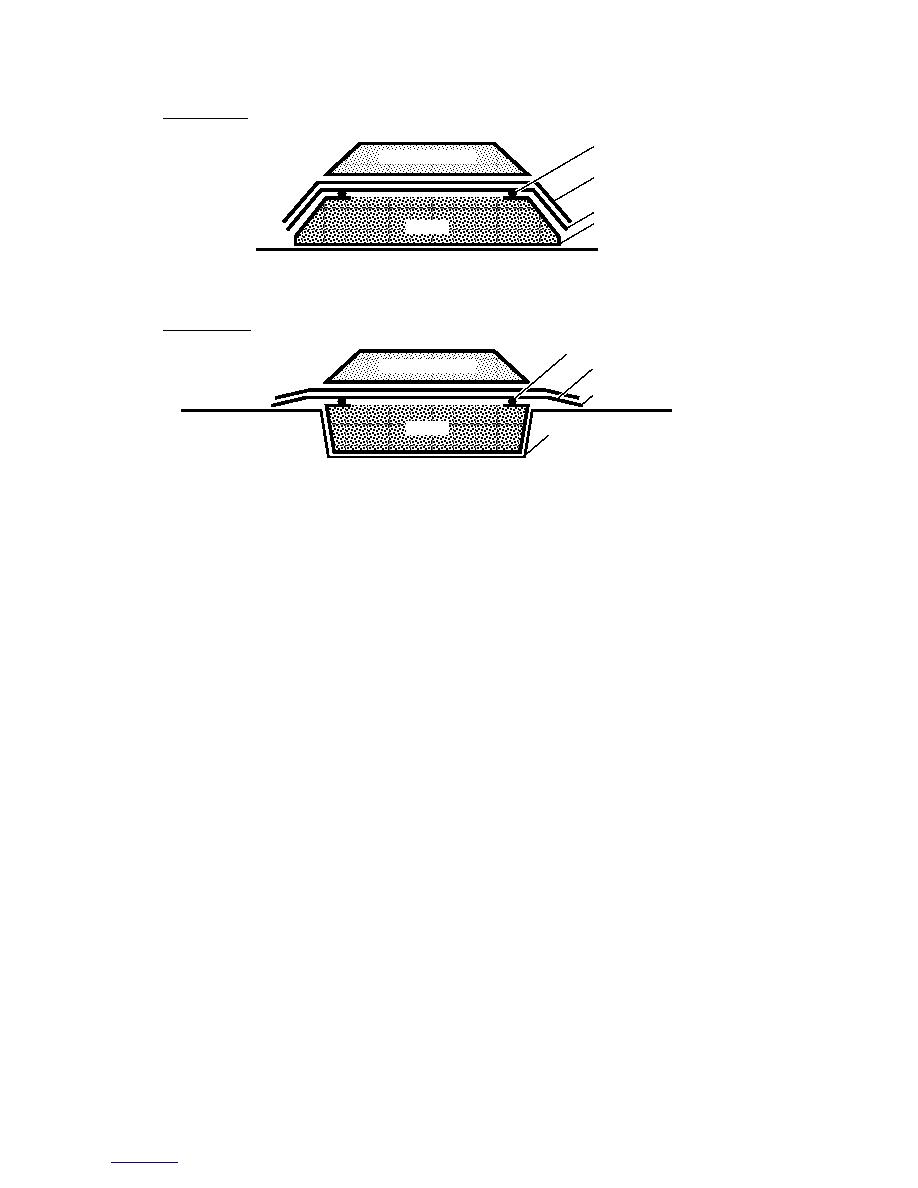
Most Expedient
Requires Borrow Soil
Membranes Exposed
Membrane Sealing
Wearing Surface
Membrane Protection
(Geotextile)
Upper Membrane (Plastic Film)
Lower Membrane (Plastic Film)
Fill Soil
Subgrade
a. On top of subgrade.
Least Expedient
Uses Native or Borrow Soil
Membrane Sealing
Membranes Protected
Membrane Protection
Wearing Surface
(Geotextile)
Upper Membrane (Plastic Film)
Subgrade
Fill Soil
Lower Membrane (Plastic Film)
b. In the subgrade.
Figure 1. Cross sections of typical MESLs.
asphalt using a chip spreader to prevent tires
Current materials
The following information is primarily from
from picking up the asphalt.
Implementation Package 74-2, Users Manual for
Membrane Encapsulated Pavement Sections (MEPS),
Membrane sealing materials
by S.L. Webster (1974b).
Emulsified asphalt is used to seal all the mem-
branes. At least a 0.3-m (1-ft) overlay should be
Lower membrane
used at all seams.
The lower membrane is formed by first spray-
Membrane protection and wearing surface
ing emulsified asphalt on the soil at a rate of 0.9 to
1.4 L/m2 (0.2 to 0.3 gal/yd2) on the subgrade.
Protection is not required if only wheeled vehi-
cles are going to use the newly constructed road.
This holds the plastic membrane in place and can
It will last for approximately 10,000 passes with
seal small punctures that occur in the plastic
very little maintenance (Webster and Andress
membrane, which is typically 0.152-mm- (6-mil)
1976, Webster 1996), but vehicles cannot make
thick polyethylene, 9.1 to 12.2 m (30 to 40 ft) wide
sharp turns or sudden starts and stops. If a gravel
and 30.5 m (100 ft) long. The membranes are
wearing surface is going to be used, 51 mm (2 in.)
joined together by overlapping the sheets by two
of "cushion" sand is used between the membrane
to three feet and spraying emulsified asphalt
and the gravel to prevent puncturing of the mem-
between them.
brane (Smith 1979). An asphaltic concrete pave-
ment wearing course will also provide the needed
Upper membrane
membrane protection (Webster and Andress
The surface of the finished soil layer is first
1976).
sprayed with a small amount of water to dampen
it, and is then sprayed with 1.1 to 2.3 L/m2 (0.25
to 0.5 gal/yd2) of emulsified asphalt. A needle-
Encapsulated soil
The encapsulated soil is typically one that loses
punched nonwoven polypropylene fabric (such
considerable strength when it gets wet, such as a
as Petromat) is unrolled on top of the emulsified
clay or silt. The soil needs to be placed at moisture
asphalt. The fabric is then sprayed with 0.9 to 1.4
L/m2 (0.2 to 0.3 gal/yd2) of emulsified asphalt. A
content near its optimum or lower in warm cli-
mates. In cold climates, where freezing of the soil
thin layer of blotter sand (dry sand passing the
will occur, the soil should be placed so it is no
number 4 sieve) is spread on top of the emulsified
2





 Previous Page
Previous Page
